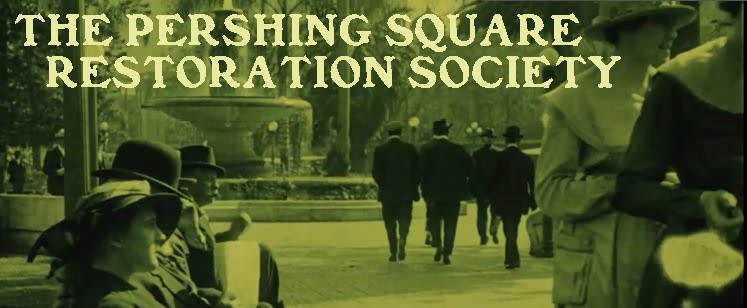Most people that go to Pershing Square today ignore the various monuments and memorials. From my own experience many people are not even aware they are there. Despite this blog and a few other articles here and there, the pieces have been forgotten by city residents. Unfortunately this is not even exclusive to Pershing Square, as memorials of all types dot southern California with little fanfare.
However, there was a time when this was not the case with regards to our park between Hill and Olive. One of the most fascinating stories I have come across in the archives of the Los Angeles Times is that of the "Wreaths in the Park."”
On April 27th, 1960, just as the clock was about to strike noon, four huge floral arrangements reaching more than six feet in height were placed in Pershing Square. They were set before the 7th California Infantry Spanish American War Memorial, the cannon from the USS Constitution, the Beethoven statue (which also honored William Andrews Clark, founder of the LA Phil), and Doughboy saluting the veterans of World War One.
Crowds gawked at these tributes, and the question on everyone's lips was "Why?" All that was left by each wreath was a simple card containing the text "With Sympathy." Stories filtered around of an elderly Asian man who was present when the flowers were delivered and bowed to each memorial before strolling away happily.
This was obviously a heckuva story. The Times quickly located the florist who had delivered the flowers and learned they were ordered by Cheong Wong, an 88-year-old who resided on Bellevue Avenue in Angeleno Heights, overlooking the Hollywood Freeway. He did not speak English so the newspaper sent a reporter who spoke Chinese to interview him. When found, Mr. Wong professed to being a mute through an improvised sign language. Standing barefoot while biting a handkerchief in his lips he provided a card printed with the West Point motto "Duty, Honor, Country." As the Times would write, "a devilish merriment" was in his eyes.
"It was his secret, this floral beauty he'd brought to the city, and he was keeping it to himself."
I try not to interject too much of myself in these posts, but I nearly always stop and read plaques and stare at statues when I pass by them. I often wonder how few people do this, versus the majority that almost never take the time to pause and ruminate on the reason that something was immortalized in this way. While such tributes seek to honor people, places, or things it is really the visitors pondering their significance who honor history and give a memorial continued life and meaning. Anyone who admires the statue of Beethoven in Pershing Square, then looks up who Mr. Clark was validates the memorial’s placement. Someone who looks at all the countries where Americans served on the reverse of Doughboy can appreciate the tremendous sacrifice this monument represents. That is why what Mr. Wong did over half a century ago moves me today, and why I want to document and restore what I can. In this way, we can afford our past the respect it deserves.
___
COURTLAND JINDRA is an amateur historian and volunteer for the United States World War I Centennial Commission.
His "Great War" interest is largely focused on America's contribution
to and remembrance of it. Delving into Los Angeles Times' archives,
Jindra has located numerous memorials to the war in L.A. County, the
first of which being the renaming of "Central Park" as "Pershing Square"
in November 1918. He is a passionate advocate for highlighting their
importance, and through them the war effort writ large.

